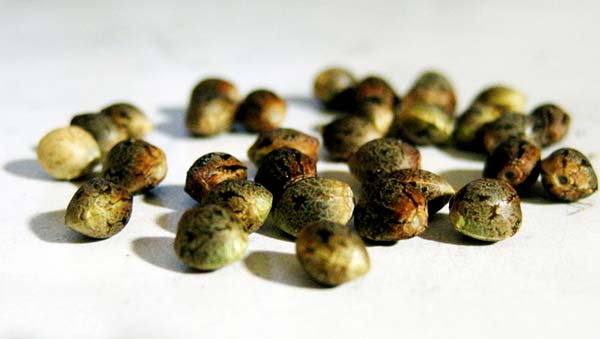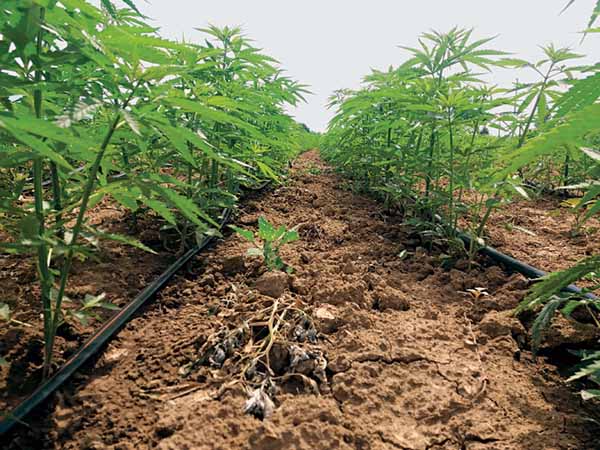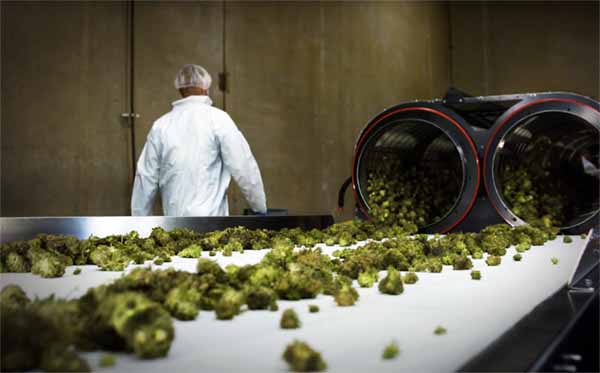Hemp flowers can be sold as a smokable product or as biomass for extraction purposes. A harvest’s cannabinoid and terpene content largely dictates price, with the higher the quantities of both the better. A key exception to this rule is the cannabinoid THC, which the must be kept below 0.3% for a crop to remain legitimate. The smokable hemp market is more lucrative than the extraction market, with cultivation and harvesting expertise crucial to achieve the crop’s highest value. Underpinning this potential is genetics, with cultivars developed for enhanced cannabinoid and terpene profiles.
Hemp Harvesting
Hemp Flower
 To capitalize on the surging popularity of smokable hemp, farmers must cultivate dioecious hemp strains bred exclusively for their flowers. To increase the harvest’s value, farmers may opt for feminized genetics to reduce the risk of male’s pollinating the crop. This would render flower unsellable as a smokable commodity and reduce its value as biomass. Feminized seeds are more expensive to procure, but the increased cost can be offset by not having to waste resources on, and remove, counterproductive males.
To capitalize on the surging popularity of smokable hemp, farmers must cultivate dioecious hemp strains bred exclusively for their flowers. To increase the harvest’s value, farmers may opt for feminized genetics to reduce the risk of male’s pollinating the crop. This would render flower unsellable as a smokable commodity and reduce its value as biomass. Feminized seeds are more expensive to procure, but the increased cost can be offset by not having to waste resources on, and remove, counterproductive males.
To produce premium hemp flowers, farmers need to procure the best genetics for their location. In regions with erratic weather at the start or end of the season, farmers may opt for varieties with temperature tolerance or shorter flowering periods, to finish before problems arise. To reduce this life cycle even further, some lines have been crossed with ruderalis genetics to produce auto-flowering hemp strains. These cultivars provide farmers a fixed harvesting date, but often at the expense of flower quantity and quality. Whichever genotype hemp farmers opt for, the variety needs to be suited for their climate and certified in the farmer’s jurisdiction.
Hemp flourishes in warm environments with light, but regular, rainfall. As a controlled crop, hemp is subject to regulatory testing for cannabinoids and contaminants. Failing either could require an entire crop to be eradicated, at the farmer’s expense. Therefore, it is essential land is regularly and rigorously tested for pollutants. Collecting soil samples not only fosters compliance, but also provides a snapshot of soil composition to inform fertilization. Soil should be slightly acidic, with a pH between 5 and 7.5, and fine enough to support early growth and drainage.
 Hemp in the Northern Hemisphere is typically sewn in early April. As autoflowering strains have a much shorter life cycle, they can be planted as late as June and still finish by October. For efficient germination soil should be above 5 ˚C, with farmers in colder climates often germinating in greenhouses first. For flower cultivation, hemp is sown at a density of approximately 2,500 plants per acre, but some sow far more. The number of plants sown is usually a balancing act, between providing enough room for hemp to grow or wasting land and fostering weeds. By planting seeds with greater density, farmers can create a canopy quicker, which deter pests but may facilitate pathogen growth in damp conditions.
Hemp in the Northern Hemisphere is typically sewn in early April. As autoflowering strains have a much shorter life cycle, they can be planted as late as June and still finish by October. For efficient germination soil should be above 5 ˚C, with farmers in colder climates often germinating in greenhouses first. For flower cultivation, hemp is sown at a density of approximately 2,500 plants per acre, but some sow far more. The number of plants sown is usually a balancing act, between providing enough room for hemp to grow or wasting land and fostering weeds. By planting seeds with greater density, farmers can create a canopy quicker, which deter pests but may facilitate pathogen growth in damp conditions.
To stimulate early growth so plants develop beyond infancy quickly, seeds should be sewn less than ¾ “ deep. In favourable conditions, seedlings should be visible within two weeks. Once seeds have germinated, farmers will be able to forecast yield and calculate their required harvesting capacity. This is essential to accelerate the harvesting process and minimize time-to-market, which provides farmers early business opportunities before supply meets demand later in the season. On average, farmers will typically yield 2,500 lbs of hemp flower per acre, but experienced operators with specialist solutions can produce substantially more.
 Soil should be treated a week before seeds are sewn, to prevent weeds when plants are young. After the first month, hemp grows so vigorously that common weeds struggle to compete. As rules governing herbicides and pesticides vary between jurisdictions, farmers should consult local regulations prior to use. Irrigation may be required during periods of draught, but moisture levels should be closely monitored to avoid mould. As a cash crop, hemp farmers must scrutinize the macro and micronutrients plants receive to yield superior flowers.
Soil should be treated a week before seeds are sewn, to prevent weeds when plants are young. After the first month, hemp grows so vigorously that common weeds struggle to compete. As rules governing herbicides and pesticides vary between jurisdictions, farmers should consult local regulations prior to use. Irrigation may be required during periods of draught, but moisture levels should be closely monitored to avoid mould. As a cash crop, hemp farmers must scrutinize the macro and micronutrients plants receive to yield superior flowers.
Hemp requires separate fertilization during vegetive and flowering phases. The required nitrogen, phosphate and potassium is dependent on growth cycle, soil condition, genetics, size and when plants will be harvested. Due to this multitude of factors, growers should adjust nutrient solutions on a case-by-case basis. Early finishing and autoflowering strains require less nutrients, but each crop will require a slightly different regime. The more experience farmers accrue, the more they can dial into the finer points of fertilization.
As a rule of thumb, during the vegetative stage hemp benefits from a high nitrogen low phosphorous mix. Nitrogen can be applied at a rate of between 125 lbs per acre, potassium at 80 lbs per acre and phosphorous at 50 lbs per acre. Once pistils begin to form, a flowering solution can be applied with less nitrogen and more phosphorous. To promote flower production, nitrogen can be dropped to 25 lbs per acre, potassium increased to 200 lbs per acre and phosphorous upped to 100 lbs per acre. Farmers should avoid foliage application wherever possible, which may leave residue and cause contamination.
Once seeds have germinated, hemp focuses on root production and remains in the seedling stage for three weeks. At week three, plants should stretch significantly and will be strong enough to tolerate fertilization. The next four to sixteen weeks, based on genetics, will be dedicated to vegetative growth, with nitrogen boosting shoot and leaf development.
After four weeks plants may need to be trimmed to remove excess foliage, which helps ventilation and sunlight to reach flowering sites. At this stage the sex of individual plants can be determined and males removed to avoid pollination. Even with ‘feminized’ seeds there remains a chance of a male of hermaphrodite plants emerging. When reproduction starts, growers must vet the crop for males and begin regularly testing for cannabinoids. This not only provides growers visibility into the crop’s potential, but also the possibility of exceeding the 0.3% THC threshold. As cannabinoids continue to develop after harvesting, plants should be cut when they approach regulatory limits. This could mean finishing a crop immaturely, but it is better to be able to sell a crop as biomass than not at all.
Photoperiodism is the biological process that prompts hemp to flower, in response to the shortening of daylight hours as the season progresses. The further from the equator, the earlier in the year plants will flower. Buds will begin to form at nodes with white pistols, which represent the plant’s flowering sites. As plants divert their energy into reproduction, vertical growth will subside and phosphorous consumption will increase. To not disrupt growth at this crucial stage, trimming should be avoided, as it deflects energy from flowering. Flowers should be harvested when trichomes have matured and contain the optimal cannabinoid and terpene content. Trichomes will turn from clear to cloudy and finally adopt an amber hue. Once pistils turn amber, sunlight, oxygen and heat can degrade cannabinoids and terpenes, so flowers need to be harvested quickly to preserve potency.

As farmers harvest hemp flower at similar times, prices start to fall as supply meets demand and the market reaches equilibrium. To achieve the highest price for flower, farmers not only need to cultivate an excellent product, but also expedite the harvesting process. When dried below 20˚C and cold cured, hemp flowers better retain their potency and consequently value. This enables farmers to ride market volatility and hold out for the right price. Harnessing hemp bucking and trimming solutions removes vegetation with limited value, which accelerates drying and mitigates pathogen growth.
Hemp is incredibly tough and can cause problems for standard harvesting equipment. Specialist bucking machine remove flowers from stems effortlessly and efficiently, preserving stalks so hemp fibre can create an additional source of income. The best devices can process wet and dry plants for greater harvesting versatility, with CenturionPro’s destemming technologies delivering feed rates that exceed 2,000 lbs of wet hemp per hour. To achieve the same processing speed manually would require a 60 strong team, which even on an hourly rate of $15 would cost $900 every hour.
The bucking solutions are built to the highest specification to ensure prized larger flowers remain intact, with the crop’s aesthetic vital to achieve the highest price point. To improve this aesthetic, and the harvest’s value, hemp flowers also need to be meticulously trimmed. A precise trim is not only desired in the smokable flower market, but also demonstrates to processors that the crop has the maximum cannabinoid to weight ratio.
CenturionPro’s trimmers provide superior performance, with the XL 10.0 capable of processing up to 3,000 lbs of wet hemp per hour. The industry leading trimmers have non-stick coatings, to preserve cannabinoid and terpene profiles, delivering hemp flower that replicates hand-trimmed product quickly, without sacrificing quality. The ability to trim wet and dry hemp empowers growers to apply a wet trim to accelerate drying, followed by a dry trim to perfect the appearance of finished flower.
Contact Us
Our staff would be happy to assist you with any questions about CenturionPro, purchasing a bud bucking or trimming machine, or replacement parts.

Book A Call
Need guidance on which trimmer is right for you?
Our sales team is always ready to work with you on finding the right machine for your harvest and future growth.
Find A Retailer
Our store locator helps find local retailers that sell CenturionPro machines and parts. If your favorite hydroponic store is not listed, they can drop-ship through us. Simply ask them to call 1-855-535-0558

Support Center
Need help with your harvest? Our support center has comprehensive video manuals, brochures, DIY tutorials, FAQs, Harvest Tips and Warranty information in one easy-to-navigate hub.


